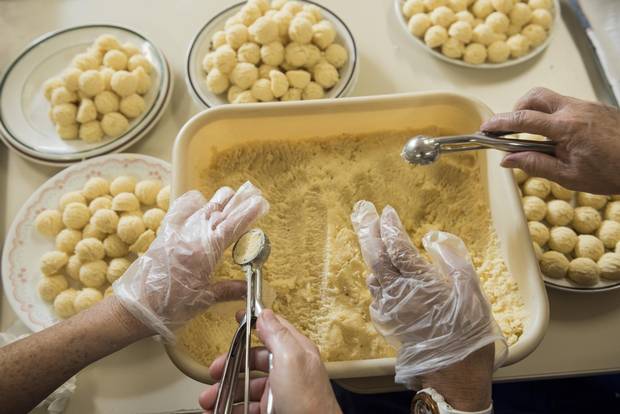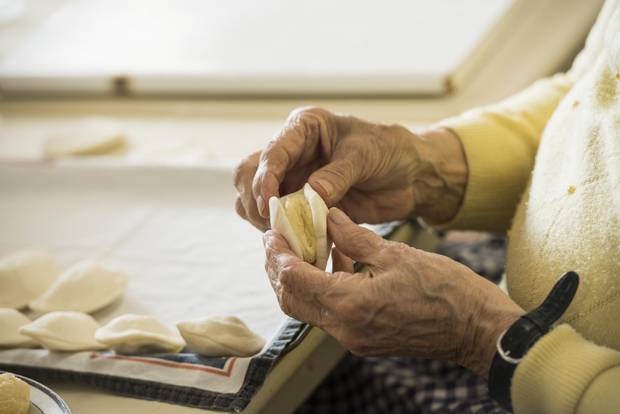In Winnipeg, the names change from parish to parish. The Pinchers, the Club, the Miracle. At St. Nicholas Church, the bowling-league-style name for the perogy team is mistakenly listed on the church's website as the Perogy Brigade. "I don't know who put Brigade," says Theresa Antoniuk. "We're the Crew."
Every Tuesday, Ms. Antoniuk, a retired teacher, leads her team of about 20 volunteer cooks in preparing the two basic elements of any perogy worth its salt: a simple dough of flour and water, and fillings that range from humble potato and onion to glamorous cottage cheese. Wednesday mornings, starting at 7 o'clock sharp, the basement of St. Nicholas becomes an even busier beehive of activity, with upward of 40 volunteers pinching, boiling, cooling and packaging hundreds of perogies, all under a tight dumpling deadline. "We have to be done by noon," she says, "because they have to set up for Bingo."
But these days, the humble perogy has more to fear than competition for church-hall space. As the world changes, and a generation passes, a staple that has long held a unique place in the cultural and gastronomic life of the Prairies is flirting with extinction. "There used to be way more [church perogy groups] than there is now," says Andrea Helgason, perogy-maker-in-chief at the church kitchen of St. Gerard Parish, whose Perogy Pinchers whip up 1,800 potato-and-cheddar dumplings a week. "Some have folded because they don't have the people. Our older ladies either passed away or had to quit because of their health. Not very many younger people join. People don't volunteer as much."
Which is bad news for perogy aficionados. In Winnipeg, says Gordon Bailey, chef and instructor at Red River College, except perhaps in an emergency, one does not buy perogies from a supermarket. ("Freezer-burned little hockey pucks" is how he describes the store-bought variety.) Least of all in this, the busiest of perogy seasons, with both Christmas and Ukrainian Christmas on the horizon. You either make your own or buy them from a church.

Anna Amborsky and Adda Morales prepare perogies in the basement of St. Gerard Parish.
And demand is high. Roughly 16 per cent of Winnipeg's population identifies as Ukrainian – giving those citizens a provenance not unlike that of perogies themselves, which trace their roots to Central and Eastern European. Since the 2011 closure of the legendary Alycia's, which served perogies endorsed by no less than the late, great John Candy – whose mother had both Polish and Ukrainian roots – no Winnipeg restaurant has really stepped up to take its place."I think it's the labour," says Colleen Swifte, the current owner of Alycia's, which has since reopened in Gimli, an hour north of here on the western shore of Lake Winnipeg. "The original Alycia's had a staff of over 30 people pinching perogies all day. In today's economy, to try to afford that number of staff is very cost-prohibitive."
Ordering them off most restaurant menus, meanwhile, gets you a product that makes perogy devotees themselves steam with barely veiled indignation. Says Chef Bailey, "In the larger restaurants, if they serve them, they're prepackaged, made somewhere else. In Manitoba, that's not even really a perogy."
And so it has fallen mostly to church crews to continue blessing hungry Winnipegers with the real deal. Your typical group operates as part artisanal-food business, part charitable fundraiser and part social club, with volunteers coming as much to chat and catch up as to roll out, fill, crimp and package their dumplings. In an era when modern food businesses have gone all high-tech – online ordering forms, Instagram marketing, mechanical sheeters for rolling or cutting dough – the underground perogy economy of Winnipeg embraces anachronism. With its system of land-line phones, cash-only payment, and bags of preordered dumplings tied to church door handles for payment on the honour system, it's a trip through a time machine.

Emma Galang, Elenita Ajusto, Margaret Kluzinski, and Lee-Ann Kluzinski of the Perogy Pinchers work in the basement of St. Gerard Parish.
One with its own time-honoured rules. While store-bought versions of the Ukrainian dumpling are made with a near-blasphemous variety of fillings – chorizo sausage, Philly cheese steak, strawberry, plum – in the kitchen at St. Nicholas, they stick to the classics: potato and cheddar, potato and onion, and potato and cottage cheese. All for a bargain (church) basement price of $5 a dozen. "We don't charge more for cottage cheese," says Ms. Antoniuk. "Some people do."
In the city's north end, the Ukrainian Orthodox Cathedral of St. Ivan Suchavsky offers a somewhat wider menu that includes, in addition to the standards, mushroom perogies and sauerkraut perogies. It also sells cabbage rolls and perishke (buns stuffed with cabbage). And nodding to both efficiency and brisk demand, Holy Eucharist Ukrainian Catholic Church, near the intersection of Munroe and Watt streets, operates a dedicated "perogy hotline" for taking orders.
Not that anyone is letting popularity compromise calibre: The website for St. Joseph's Ukrainian (a church that is also home to the holy relics of Bishop and Martyr Blessed Vasyl Velychkovsky) notes that "quality control" at its monthly perogy bees "is assured by the many Moms and Babas that show up faithfully to pinch and roll."

Cheese-and-potato perogy filling is balled as part of the preparation process.
At. St. Gerard, Ms. Helgason only recently bought a shiny new Hobart mixer to make dough. But her team is still rolling that dough out by hand. "It's very old-fashioned," says Ms. Helgason. "We don't have a fancy machine. Maybe that's why everybody likes it. They're not all perfect."
And as befits a product made by those who take earthly inspiration from celestial sources, it's not uncommon for perogies to be leveraged for the greater good. The September-to-June perogy program at St. Gerard, for one, raises funds to help students pay tuition at St. Gerard Catholic School, which runs about $1,000 a student.
But for all the good – and good eating – that church-made perogies deliver, it remains a fact that their earthly days are likely numbered. At St. Nicholas, whose perogy program launched in the 1940s, Ms. Antoniuk notes that "all our people are retired. You have to be retired to work with perogies. Our oldest lady is 93. She's the one that cuts the potatoes." These days, her Perogy Crew doesn't get a lot of new recruits. "They're not coming, the younger ones," she says. "If I quit, there will be no perogies, because nobody wants my job."
Or, at least, almost nobody. "My mom has just started, for December, selling her perogies because of popular demand," says Chef Bailey. "I grew up on perogies, making perogies, eating perogies. And I'm not even Ukrainian or Polish. I'm Irish." In Winnipeg, he adds, "You can't escape the perogy. It's part of our heritage."
